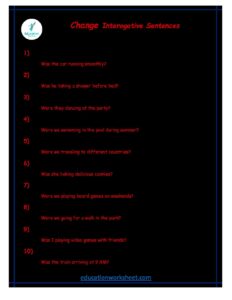Change to Past Continuous form interrogative
Change to Past Continuous form interrogative How can Change to Past Continuous form interrogative
Effective communication is a fundamental skill, and mastering the nuances of grammar can greatly enhance your ability to express yourself clearly. One aspect of grammar that often comes into play when discussing past events is the past continuous tense. Understanding how to change sentences from their simple past form into past continuous interrogative questions is a valuable skill for anyone learning English or seeking to improve their language proficiency. In this comprehensive guide, we will delve into the intricacies of this transformation, offering detailed explanations, helpful examples, and practical insights to empower you with the knowledge you need.
The Basics of Past Continuous Tense
Before we dive into the transformation process, it’s crucial to grasp the basics of the past continuous tense. This tense is used to describe actions that were ongoing or in progress at a specific point in the past. It’s formed by combining the past tense of the verb “to be” (either “was” or “were”) with the base form of the main verb plus “-ing.”
The Transformation Process
To change a sentence from simple past to past continuous in an interrogative form, you can follow a step-by-step process
1. Identify Change to Past continuous form interrogative sentence
Start by identifying a sentence in its simple past form. For example, let’s take the sentence: “She sang a song.”
2. Identify the Subject and Verb: Break down the sentence to identify the subject (in this case, “She”) and the main verb (“sang”).
3. Transform the Verb: Change the main verb from its simple past form to the base form and add “-ing” to it. In our example, “sang” becomes “singing.”
4. Add the Appropriate Form of “to be”: Depending on the subject, use either “was” (for singular subjects) or “were” (for plural subjects). In our example, since the subject “She” is singular, we use “was.”
5. Rearrange the Sentence: Place the subject and the appropriate form of “to be” at the beginning of the sentence. In our example, it becomes: “Was she singing a song?”
6. Add a Question Mark: Finally, don’t forget to add a question mark at the end of the sentence to indicate that it’s an interrogative question.
Examples and Explanations

Now, let’s explore a few more examples to reinforce your understanding of this transformation process:
1. Original Sentence: “They ate dinner.”
- Past Continuous Interrogative: “Were they eating dinner?”
- Explanation: “Ate” (simple past) is transformed into “eating” (base form + “-ing”), and “They” is followed by “were” to create the interrogative question.
2. Original Sentence: “He watched TV.”
- Past Continuous Interrogative: “Was he watching TV?”
- Explanation: “Watched” becomes “watching,” and “He” is preceded by “was” to form the interrogative question.
3. Original Sentence: “I played basketball.”
- Past Continuous Interrogative: “Was I playing basketball?”
- Explanation: “Played” changes to “playing,” and “I” is used with “was” to create the interrogative form.
4. Original Sentence: “She wrote a letter.”
-
Change to Past Continuous form Interrogative
- “Was she writing a letter?”
- Explanation: “Wrote” transforms into “writing,” and “She” is coupled with “was” to construct the interrogative question.
Common Errors and Tips
While transforming sentences into past continuous interrogative questions is relatively straightforward, there are some common errors to be aware of and helpful tips to keep in mind:
1. Subject-Verb Agreement: Ensure that the form of “to be” (either “was” or “were”) matches the subject of the sentence. Use “was” for singular subjects and “were” for plural subjects.
2. Verb Transformation: Always change the main verb to its base form and add “-ing” to it when forming the past continuous tense.
3. Sentence Structure: Remember to rearrange the sentence so that the subject and “to be” appear at the beginning, followed by the transformed verb and the rest of the sentence.
4. Question Mark: Don’t forget to add a question mark at the end of the interrogative question to indicate that it’s a question.


